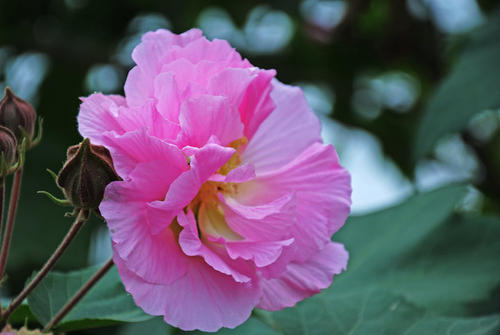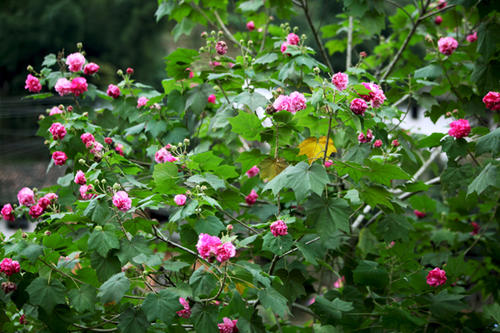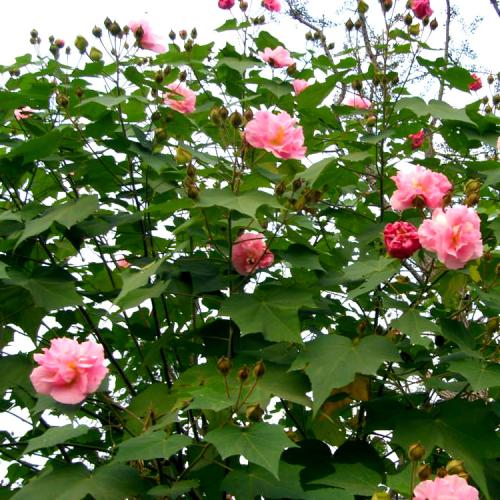How to Care for Hibiscus Mutabilis Plant (Confederate Rose)
Written by Maggie
Aug 31 2021

The Hibiscus mutabilis (Confederate rose) originally came from China and was introduced to the United States in the 1600s. This plant is not actually the rose as the name suggests. It is famous for its single-petal and double-petal blooming flowers. With age, the flowers change from white to pink to red. This Hibiscus mutabilis can reach a height of 15 feet and a propagation distance of about 10 feet. It grows best in the USDA Plant Resistance Zone 7 to 11. Point or border plants in the garden.

Tips for Hibiscus mutabilis Care
If you live in the northern part of the USDA hardiness zone of the plant, you can choose to have the same-age rose as an annual or put it in a container, once the night temperature reaches 40 degrees Fahrenheit, you can grow hibiscus mutabilis (Confederate Rose) indoors.
Fertilizer for Hibiscus mutabilis Care
Since the Hibiscus mutabilis (Confederate Rose) are sensitive to too much fertilizer, it is best to use a balanced time-release formula, such as 10-10-10 products. Apply fertilizer twice a month for best results, and be sure to read and follow the product label to understand the application details, dosage and time. Or, you can skip the fertilizer altogether, but the plant will grow much slower.
Hibiscus mutabilis Water Requirements
Water the Hibiscus mutabilis every week to make their garden beds slightly wet, but not soaking. In the hot summer months, you may need to water the plant more frequently because it prefers direct sunlight or direct sunlight for at least six hours. The hot summer sun will dry the soil much faster than the mild spring months.
Pruning Hibiscus mutabilis in Winter
Wait until winter, and then start pruning Hibiscus mutabilis (Confederate Rose). Unless you live in a frost-free climate, this perennial plant will lose its leaves, and once winter comes, many stems will die on their own. Use sterilized pruning shears to cut the remaining stalks back a few inches above the ground. In spring, new shoots will appear at the roots of the plant, and soon thereafter, the plant will flourish as it did the previous summer.

Hibiscus mutabilis Care
Before and after using pruning tools, clean and disinfect them to help prevent the spread of disease. Wipe off all dust and debris with a damp cloth, then soak the blade in a solution of 1 part bleach to 9 parts water. After 30 minutes, rinse them thoroughly with clean water and air dry.
Common pests of Hibiscus mutabilis
Pay attention to the common pests aphids, whiteflies and red spiders in hibiscus plants. Check for aphids on the underside of the leaves. The length of the aphids is less than 1/4 inch and the color of the pear-shaped body is different; the whitefly looks like a small white moth. And spider mites, they are only 1/20 inch long or smaller and need a magnifying glass to see them. Use insecticidal soap to destroy any insects you find. The soap must be in contact with harmful organisms to be effective. Use in the early morning or evening, and thoroughly soak the plant, including the underside of the leaves. To prevent future infestations, wash the leaves of the Hibiscus mutabilis with water from the garden hose weekly to clean the leaves of the plants.
Hibiscus mutabilis Disease
Check your Hibiscus mutabilis (Confederate Rose) occasionally to detect diseases early. Two common diseases of this plant are leaf spot and southern stem blight, both of which are fungal infections. You can identify leaf spots by the brown circles formed on plant leaves. To control leaf spot, you need to remove all infected leaves and clean up all debris around the plant. If your confederate rose suffers from southern stem and leaf blight, you will find a brown disease at the bottom of the plant near the soil line. Prevent the mulch from touching the stem of the plant to prevent the recurrence of southern stem blight. In both cases, you can choose to use a fungicide, but this type of chemical should only be used if all other methods (such as culture control) have failed. If you decide to take this route, please consider contacting your local county extension office for help to correctly diagnose the disease and choose the appropriate chemical for treatment or prevention.

Latest Updated
- Benefits of Bugleweed - 7 Science-backed Health Benefits
- Bugleweed Dangers & Side Effects - Is It Poisonous?
- How to Plant Evergreen Trees - What You Should Know
- When to Plant Evergreens - Grow Guide for Evergreen Trees
- 12 Wonderful Evergreen Shrubs for Your Garden
- 12 Popular Evergreen Plants with Pictures for Beginners
- When And How To Prune A Lilac Bush Like a Pro
- How to Grow & Care for Lilac Vine (Hardenbergia Violacea)
- Japanese Lilac Tree (Syringa Reticulata) Care & Propagation Guide
- Shumard Oak Pros and Cons - What to Know
Popular Articles
- Winter maintenance of Antirrhinum Majus
- How to Grow Terminalia Mantaly Tree
- How to Grow and Care for Crossostephium Chinense
- How to grow Antirrhinum Majus in spring
- Peristeria Elata (Dove Orchid) Profile: Info & Care Guide
- Underwatered Snake Plant (Sansevieria Trifasciata) - Signs And How To Fix
- How to Care for Brazilian Jasmine Plant (Mandevilla Sanderi)
- How to Grow & Care for Graptopetalum Purple Delight in Summer
- Rosa Chinensis (China Rose): Plant Growing & Care Tips
- How to Care for Baby Sun Rose (Aptenia Cordifolia)